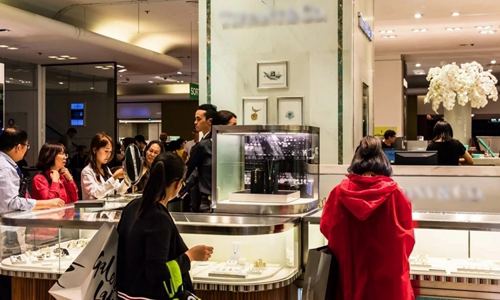At the luxury shopping center in London, the number of Chinese students engrossed in shopping is as much as the rich Europeans.
The main customers of the luxurious Harrods shopping mall or Selfridges shopping center in London, England were often the wealthy retirees, European tourists and local fashion followers. But the vendors here are increasingly familiar with a new class of customers, that is, Chinese students who "spend money without thinking".

A jewelry store at the Galeries Lafayette French commercial center Photo: SCMP
This scene is not just in the British capital. On the shopping streets in Los Angeles, Chinese students from the University of California Los Angeles, Southern California University and California State University spend as much as Hollywood stars.
In the US East Coast, Chinese students studying at Parsons School of Design and Columbia University accept large sums of money to rent apartments on Fifth Avenue, one of the world's most expensive shopping streets.
Similar scenes take place in Melbourne, Paris and Vancouver, where rents have risen in areas popular with young Chinese. While indigenous students often buy only affordable brands, Chinese students are provided with the family's dream money.
Annabel Yao, a 22-year-old computer science student at Harvard, is the daughter of Huawei founder Ren Zhengfei. On social networking sites, she posts travel photos around the world with a huge collection of branded brands.
Wang Tu Thong, the son of one of China's richest people Wang Jianlin, studied at the University of London (UCL). He once bought a smart watch for a pet dog and paid $ 105 million for an apartment in the upper Kensington neighborhood.
"These are the customers that brands are looking for," said Melody Yeh, chief executive of Recenting Communications, a London-based marketing company. "They have great purchasing power. In order to come to England to study abroad, they must come from wealthy families."
"We calculate that every year a Chinese student in the UK spends around £ 28,000 (US $ 37,000) on personal purchases, excluding rent or living bills. Each student will have about 3-5 from China visiting every year and of course they go shopping together. So brands want to get their attention, "Yeh said.
These students are increasingly popular at Western universities. Chinese accounted for more than 40% of the total international student in the UK last year and about 33% in the US and Canada.
Sending children to study abroad has become one of the main goals of both the super-rich and the well-off middle class in China. A recent survey by Kai Tak Education showed that 83% of Chinese millionaires want their children to study abroad, mostly in the West. Based on the estimation by Swiss bank Credit Suisse that more than 100 million Chinese are among the top 10% of the richest people in the world, we can see just how much Chinese students study in the West.
The influx of Chinese students into European and American cities has created an industry to market their goods and services. There are websites written entirely in Chinese, advising Chinese students on shopping.

Annabel Yao at the upscale prom in Paris in November 2018 Photo: Le Bal des Debutantes.
Tao Liang was a student in New York. He is famous online with the nickname "Mr. Handbag", has more than 3.5 million followers on Weibo and more than 850,000 on WeChat. Last June, in just 6 minutes, Liang helped an Italian leather company sell handbags worth 3.24 million yuan (US $ 460,000). Last year, he helped a French luxury company sell 1.2 million yuan worth of handbags in 12 minutes.
"The best way to attract these Chinese students is to target Chinese KOLs (influencers) who live in the US or the UK, because students will follow them to learn," Yeh said.
"Another important thing to do is promote goods on Weibo and WeChat because studies show that students are more likely to stick with Chinese social networking platforms than use international apps like Instagram or Twitter."
Yeh also said that companies need to reach these customers by creating intimacy, such as targeting the lunar new year, singles 11/11 and Golden Weeks (holidays lasting from 7-8 dates in China). "They live in the UK or the US but they still celebrate those occasions and such an approach will attract them," she said.
Brands with a strong national identity can also attract students because they are trying to adapt and integrate into new places. Equally popular are the brands that allow students to personalize, like designing and decorating to show their personalities.
The United States has always been the top choice for Chinese students, but the U.S.-China trade war has led more and more Chinese students to study in the UK instead of the United States. This could be a major driver for the British fashion industry, which has struggled since its referendum and decided to leave the EU in 2016.
"Trump's comments about China are so full of coverage, he is making it more difficult for Chinese people to apply for a student visa in the US. As a result, Chinese students first say that the UK is their top choice for studying abroad. This is very important for the local fashion industry, "Yeh said.
According to this marketing expert, Brexit and rising anti-immigrant Europeanism will somewhat affect Chinese students, but the impact is not great. "Brexit makes the pound mean that prices in London are more affordable than before," Yeh said.
"In addition, the UK has just loosened working visas for Chinese students, who have postgraduate degrees in the UK will be allowed to work here for the next two years. That's very interesting," she added. .
See also: Chinese talents in the US hesitate between staying or returning



 ValinteJesza
ValinteJesza







